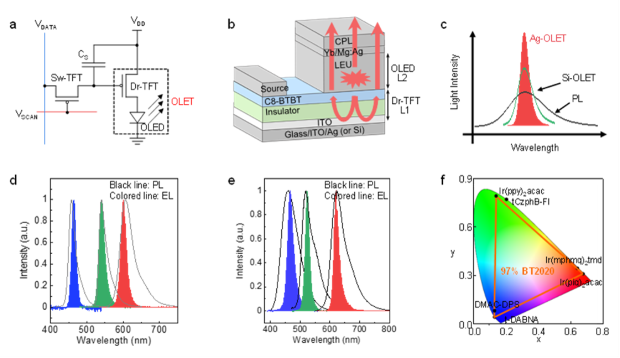Researchers develop high-efficiency narrow-emission organic light-emitting transistors with intrinsic multi-order microcavity
Prof. DONG Huanli from the Institute of Chemistry, Chinese Academy of Sciences, together with Prof. HU Wenping from Tianjin University, has developed an integrated organic light-emitting transistor device, whose unique stacked structure, combining a horizontally driven field-effect transistor and a vertical light-emitting diode, endows it with intrinsic multi-order microcavity characteristics, demonstrating great potential for achieving ultra-narrow emission spectra in electroluminescent devices.
Narrow-spectrum electroluminescent devices are of great significance in wide color gamut displays, optical communication, and phototherapy. However, achieving narrower emission spectra, especially breaking through the technical bottleneck of full width at half maximum (FWHM) below 20 nm, remains a great challenge.
The researchers utilize the intrinsic multi-order microcavity structure formed by the unique stacking of field-effect transistors and light-emitting diodes in novel planar OLETs by introducing a fully reflective substrate and a transparent top electrode. Guided by theoretical simulations, the strong microcavity effect enables effective spectral narrowing and enhances device efficiency for red, green, and blue emitters with intrinsic broad/narrow spectra. The minimum FWHM values of red, green, and blue OLETs reach 18, 14, and 13 nm, respectively. Compared to photoluminescence spectra, the maximum spectral narrowing achieves 68%, with the color gamut covering 97% of the BT.2020 standard. Moreover, the spectral narrowing effect remains stable and independent of gate voltage.
Further investigation revealed that, along with superior narrow-emission characteristics, the OLETs also exhibit higher current efficiency/blue index values than equivalent comparative devices due to their unique gate regulation capability. The peak current efficiencies/blue index of red, green, and blue OLETs reach 26.3 cd/A, 37.3 cd/A, and 72.6, respectively, representing the highest reported values in the field. This method provides a new strategy for developing high-color-purity and high-efficiency electroluminescent devices, offering significant potential for advancing related applications.
This breakthrough marks an important step in high-efficiency narrow-emission electroluminescent devices, and opens new possibilities for more realistic imaging, higher-capacity data transmission, and specialized medical applications.
This study was published in Nature Materials.

Intrinsic multi-order microcavity organic light-emitting transistors achieving spectral narrowing (Image by Miao Zhagen)
Contact:
Prof. DONG Huanli
Institute of Chemistry, Chinese Academy of Sciences
Email: dhl522@iccas.ac.cn





